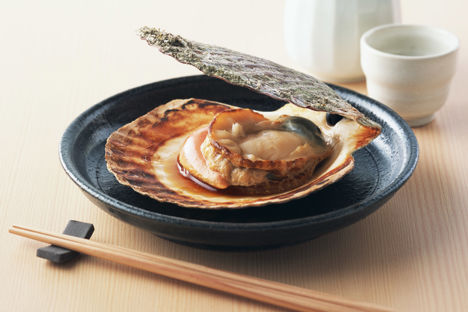
Seafood of Japan: scallops
There are few seafood delicacies more prized than delicate, meaty scallops, and for good reason. Those found off the coast of Japan are among the world’s most coveted – we find out why and explore ways to cook them.
Seafood of Japan: scallops
There are few seafood delicacies more prized than delicate, meaty scallops, and for good reason. Those found off the coast of Japan are among the world’s most coveted – we find out why and explore ways to cook them.
Seared in butter, cured in a tartare or poached in a rich sauce; however they’re cooked, scallops add a touch of elegance to any dish. It’s no surprise that they’re a common addition to dinner party menus, often served in their pretty, fan-shaped shells, but scallops are simpler to prepare than we might think, and can be an easy upgrade to a simple weeknight supper. What matters most is choosing the right scallops; good quality ones will be firm in texture, opaque in appearance and smell fresh like the sea (rather than overly fishy) and when cooked, they should be soft yet meaty with a delicate sweetness. Scallops from Japan are prized for their size and flavour, and while they have long been sought after by top chefs and sushi masters, they are fast becoming one of Japan’s most popular culinary exports, having reached a record high in 2022.
When we talk about Japanese scallops, we are usually referring to ones which come from the country’s two largest farming regions, Hokkaido and Aomori, off the northern Pacific coast, although there are other production areas, including Iwate and Miyagi. These scallops are used widely in Japanese cooking, though many are exported to China and countries further afield, including America and the UK (they are frozen before being shipped, but Japan's processing technology, which instantly freezes the scallops, means they retain their quality and can still be eaten raw after thawing). They are sold fresh and trimmed in Japan (leaving just the ‘ligament’, or the meat, which is actually a muscle that closes and opens the shells as they swim), but can also be bought with the roe and frill attached; the frill, or himo in Japanese, can also sometimes be found dried and roasted as a bar snack there.
When it comes to preparing the scallops, a first port of call is often to enjoy them fresh and raw as sashimi or sushi, or served alongside steamed rice, which are all popular methods in Japan. They also work perfectly in carpaccio or ceviche, both brilliant yet simple ways to highlight their sweetness. In Japan, when they are cooked, they can often be found grilled with butter in the country’s yakitori bars, chargrilled in their shells or simmered in soups. In Aomori, where scallops are abundant, they are served in kaiyaki miso, simmered in the shell with beaten egg, miso and stock. Scallops require little cooking, making pan-searing one of the most popular cooking methods around the world – when done right, it creates the best of both worlds; a caramelised, charred outside and soft, slightly translucent centre (you can see our how to cook guide here, but a good rule of thumb is two minutes on one side and anything from ten seconds to two minutes on the other). Like most seafood, cooking scallops en-papillote, in water, milk or stock, perhaps, simmering or poaching them, also helps to lock in moisture, though they can also be deep-fried, as tempura, for example.
The nutrient-rich waters that surround Japan provide ideal growing conditions for scallops, whether that’s in tidal currents or still bay waters where the shellfish can mature slowly, resulting in an intense, rich flavour. While plenty of Japanese scallops are caught in the wild, the country’s fishermen have also developed production techniques, including the hanging method, where young scallops are suspended in seawater while they mature, before being farmed (usually from winter to spring), as well as seabed dredging, where they mature on the seabed for three to four years before being harvested (usually from early summer to autumn). As well as tasting delicious, scallops are also loved for their health benefits; they are a good source of protein and low in fat, as well as being rich in omega-3 fatty acids, healthy fats, magnesium, iron, zinc, taurine (an amino sulfonic acid) and B vitamins.
We know our cooking is only as good as our ingredients, and seafood – and scallops in particular – leave nowhere to hide when it comes to quality. Loved for their delicate texture and sea-sweetness, the scallops of Japan are the perfect example of just that. Whether the end goal is beautifully fresh sashimi, a perfect seaweed-butter caramelisation or an indulgent seafood spaghetti, investing in quality is well worth it. Scallops are already a fixture on the menus of the country’s best restaurants and among many chefs’ favourite ingredients; perhaps we will continue to see more Japanese scallops given a starring role.
Feeling inspired to use Japanese scallops in your cooking at home, you can buy them now via the links below.
Atariya | Japan Centre | Fine Food Specialist | WASO | Yutaka

